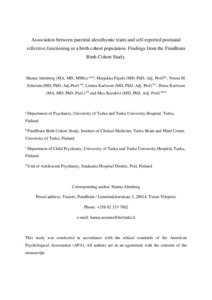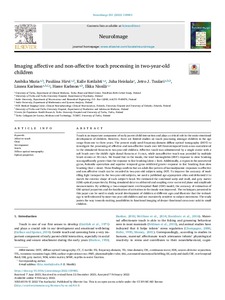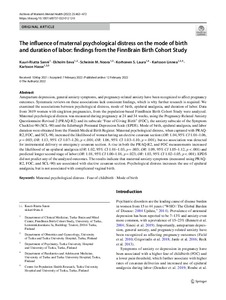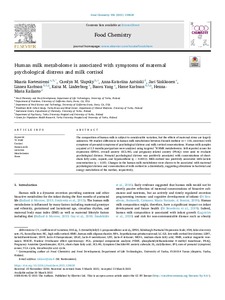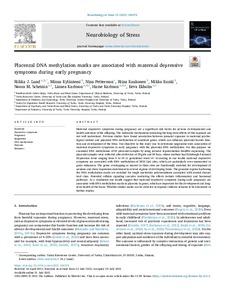Hae
Aineistot 61-67 / 67
Brain charts for the human lifespan
<p>Over the past few decades, neuroimaging has become a ubiquitoustool in basic research and clinical studies of the human brain. However, no reference standards currently exist to quantify individual differences in ...
Association between parental alexithymic traits and self-reported postnatal reflective functioning in a birth cohort population Findings from the FinnBrain Birth Cohort Study
Parental reflective functioning (PRF) refers to a parent's effort to see his/her child as a separate individual person from early on, and to be curious of the child's own thoughts and feelings. Parenting abilities are ...
Imaging affective and non-affective touch processing in two-year-old children
Touch is an important component of early parent-child interaction and plays a critical role in the socio-emotional development of children. However, there are limited studies on touch processing amongst children in the age ...
The influence of maternal psychological distress on the mode of birth and duration of labor: findings from the FinnBrain Birth Cohort Study
<p>Antepartum depression, general anxiety symptoms, and pregnancy-related anxiety have been recognized to affect pregnancy outcomes. Systematic reviews on these associations lack consistent findings, which is why further research is required. We examined the associations between psychological distress, mode of birth, epidural analgesia, and duration of labor. Data from 3619 women with singleton pregnancies, from the population-based FinnBrain Birth Cohort Study were analyzed. Maternal psychological distress was measured during pregnancy at 24 and 34 weeks, using the Pregnancy-Related Anxiety Questionnaire-Revised 2 (PRAQ-R2) and its subscale "Fear of Giving Birth" (FOC), the anxiety subscale of the Symptom Checklist-90 (SCL-90) and the Edinburgh Postnatal Depression Scale (EPDS). Mode of birth, epidural analgesia, and labor duration were obtained from the Finnish Medical Birth Register. Maternal psychological distress, when captured with PRAQ-R2, FOC, and SCL-90, increased the likelihood of women having an elective cesarean section (OR: 1.04, 95% CI 1.01-1.06, p = .003; OR: 1.13, 95% CI 1.07-1.20, p < .001; OR: 1.06, 95% CI 1.03-1.10, p = .001), but no association was detected for instrumental delivery or emergency cesarean section. A rise in both the PRAQ-R2, and FOC measurements increased the likelihood of an epidural analgesia (OR: 1.02, 95% CI 1.01-1.03, p = .003; OR: 1.09, 95% CI 1.05-1.12, p < .001) and predicted longer second stage of labor (OR: 1.01, 95% CI 1.00-1.01, p = .023; OR: 1.03, 95% CI 1.02-1.05, p < .001). EPDS did not predict any of the analyzed outcomes. The results indicate that maternal anxiety symptoms (measured using PRAQ-R2, FOC, and SCL-90) are associated with elective cesarean section. Psychological distress increases the use of epidural analgesia, but is not associated with complicated vaginal birth.</p>...
Human milk metabolome is associated with symptoms of maternal psychological distress and milk cortisol
<p>The composition of human milk is subject to considerable
variation, but the effects of maternal stress are largely unknown. We
studied differences in human milk metabolome between Finnish mothers (n = 120,
secretors) with symptoms of prenatal symptoms of psychological distress
and milk cortisol concentrations. Human milk samples acquired at
2.5 months postpartum were analyzed using targeted <sup>1</sup>H NMR metabolomics.
Self-reported scores for depression (EPDS), overall anxiety (SCL-90),
and pregnancy-related anxiety (PRAQ) were used to evaluate psychological
distress. Prenatal psychological distress was positively associated
with concentrations of short-chain fatty acids, caprate, and
hypoxanthine (q < 0.0012). Milk cortisol was positively associated with lactate concentration (q < 0.05).
Changes in the human milk metabolome were shown to be associated with
maternal psychological distress and concentration of milk cortisol in a
dissimilarly, suggesting alterations in bacterial and energy metabolism
of the mother, respectively.</p>...
Prenatal Glucocorticoid-Exposed Infants Do Not Show an Age-Typical Fear Bias at 8 Months of Age – Preliminary Findings From the FinnBrain Birth Cohort Study
<p>Synthetic glucocorticoids (sGC) are frequently administered to pregnant women at risk for preterm delivery to promote fetal lung maturation. Despite their undeniable beneficial effects in lung maturation, the impact of ...
Placental DNA methylation marks are associated with maternal depressive symptoms during early pregnancy
<p>Maternal depressive symptoms during pregnancy are a significant risk factor for adverse developmental and health outcomes of the offspring. The molecular mechanisms mediating the long-term effects of this exposure are ...

